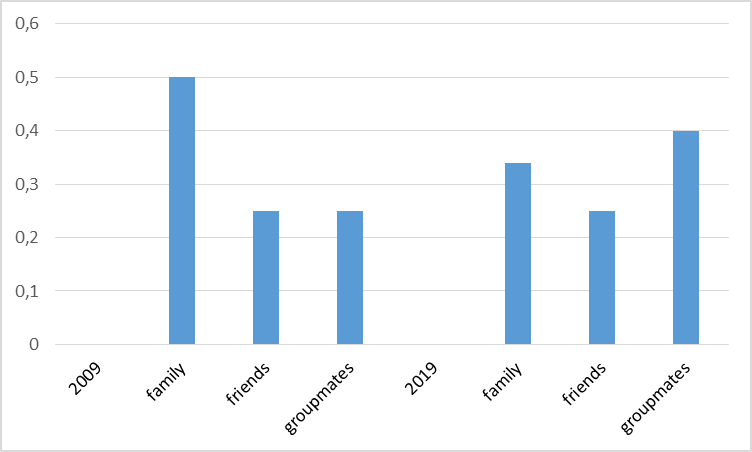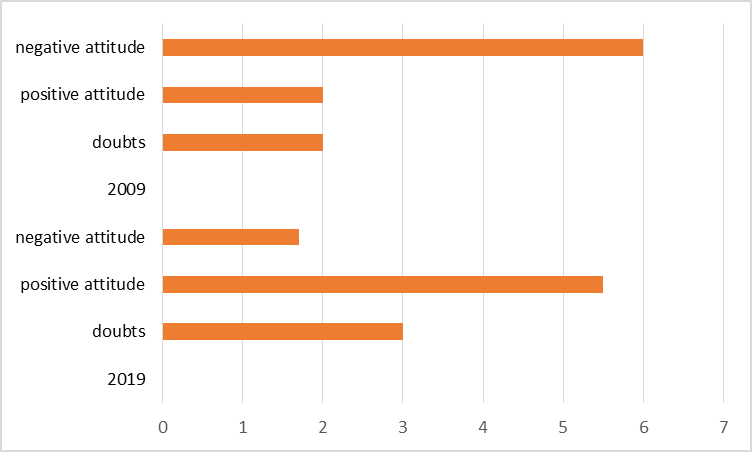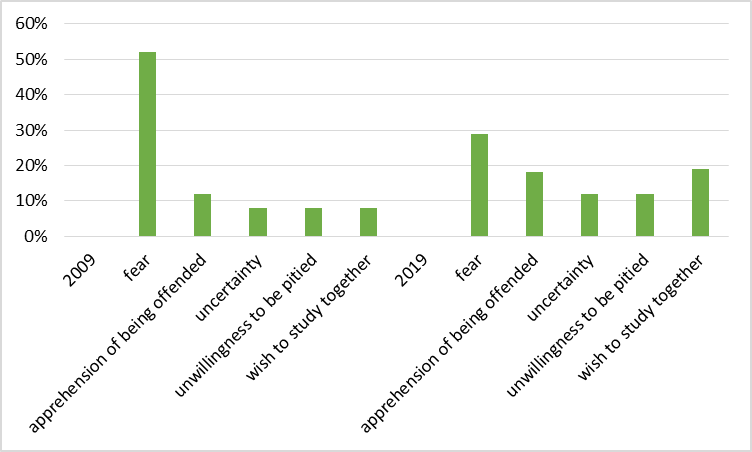Abstract
The integration of people with health limitations in society is the process of restoring the broken ties between them and society, which ensures their inclusion in the main areas of life (work, daily routine, rest, leisure). The main task facing our country is forming such an environment that contributes to the overall improvement of social climate and does not prevent persons with disabilities from living a full and happy life. Higher education, which is an integral aspect of integration for such people, is carried out in the specific sociocultural environment of the university, formed by three factors: students, teachers and administration. Each of these groups is characterized by its own perception of the problem due to the difference in role positions within the educational process. In this paper the authors compare the results of two relevant studies, conducted in 2009 and 2019 respectively. The factors considered are the contacts (family, friends, etc.) and the attitude to coeducation (from negative to positive) of physically challenged students. In the second aspect the changes are really drastic, which should be the result of the latest inclusive measures that followed the issuing and coming into force of the Federal Law “On the Education in the Russian Federation”. The integration of physically challenged students in the higher education system helps them to receive a profession, achieve success in life and career, perceive themselves as harmonious and useful individuals.
Keywords: Disabilitieshealth limitationshigher educationintegrationphysically challenged students
Introduction
The highest mission of modern education is to form the fundamental values that would enrich and develop the human personality (Astashev et al., 2014; “Inclusion of Students…”, 2007; Nigmatov et al., 2014; Samokhin et al., 2016; Winter & O’Raw, 2010). Nowadays only a small part of people with disabilities can receive higher education, find work, create a family, fulfill their personal potential. However, there are outstanding individuals who, even despite their disability, were able to achieve high results – and some of them even changed the world. The graphic examples are Franklin Roosevelt, the US president who overcame the Great Depression in his state and established fruitful relations with the Soviet Union, and Stephen Hawking, a great researcher in the field of quantum mechanics, theoretical physics and space. At school the future Nobel laureate was practically the first from the end, but after entering Oxford University he began to solve the most complex problems with lightning speed and impressed everyone with the abstractness of his intellect. Outstanding results were also achieved by Peter Dinklage (famous actor), Sylvester Stallone (prominent actor and film director), Nicholas Vujicic (president of a charitable organization), etc.
Problem Statement
The personality of a student with disabilities in the higher education system is determined by the existing problems of adaptation to the educational process (Boginskaya, 2016; Mukhametzyanova & Bogovarova, 2015; Samokhin et al., 2017; Studenty-invalidy, 2010; Zhang et al., 2018). There are about 13 million people with disabilities in the Russian Federation, of which 20% are youth. Article 26 of the European Charter guarantees the right of physically challenged persons to “independence, social and occupational integration and participation in the life of the community” (European Parliament, 2012). The Russian government does not ignore the problem of integrating this population group, which is reflected in the Federal Law No. 181-FZ “On the Social Protection of Persons with Disabilities in the Russian Federation” and its practical implementation – providing the target audience with the unhindered access to the objects of social, engineering and transport infrastructures, creating a barrier-free environment (Simatova et al., 2017; The State Duma, 1995).
The integration of people with health limitations in society is the process of restoring the broken ties between them and society, which ensures their inclusion in the main areas of life (work, daily routine, rest, leisure). The main task facing our country is forming such an environment that contributes to the overall improvement of social climate and does not prevent people with disabilities from living a full and happy life.
Research Questions
According to foreign and domestic authors (Artyushenko, 2010; Kusimo & Chidozie, 2019; Merola et al., 2019; Minazova, 2019; Shaidulina et al., 2015), integration includes the conditions under which a student with disabilities actively interacts with other students in all spheres of life (academic, leisure, social). However, integration commonly occurs only at the level of educational activity, i.e. intensive interaction between students with health limitations and other students is established and implemented only within the educational process. As for leisure and social activities, the needs of physically challenged people are not considered to the right degree.
The role of physically challenged people’s behaviour in their own integration
It should not be forgotten that integration depends on physically challenged students themselves. It may fail if they are not communicative, do not interact with their groupmates in the classroom and beyond it. An obstacle to the integration of students with disabilities is the speculative position they sometimes use, when they seek some kind of allowance, lowering the demands on themselves on the part of teachers, peers and society in general.
Integration of physically challenged people within higher education
Higher education for persons with disabilities is an integral aspect of integration. Higher education is carried out in the specific sociocultural environment of the university, formed by three factors: students, teachers and administration. Each of these groups is characterized by its own perception of the problem due to the difference in role positions within the educational process.
Purpose of the Study
The integration process is problematic due to the difficulties in the relationship of physically challenged people with others. These are unproductive and offensive emotional reactions of healthy people to persons with health limitations (awkwardness, tactless curiosity and even sometimes ridicule), on the one hand, and their negative emotions (excessive self-pity, expectation of hyper-custody, hostile attitude towards others), on the other hand. The relationship between people with disabilities and healthy ones implies their responsibility for this relationship, awareness of equal rights and opportunities for their implementation. Therefore, the interaction between these two major groups is a leading factor in social integration, and its most important condition is introducing the idea of equal rights and opportunities into the public consciousness, which is the purpose of our study.
Research Methods
The survey of students and teachers was aimed at comparing its results with the data obtained in 2009, when the study invloved 34 students (including 5 with disabilities) and 5 teachers of the Psychology Department of Tver State University (Karavanova, 2009). In 2019 the research embraced a similar number of participants: 32 students (including 4 with disabilities) and 6 teachers. The factors considered were the contacts (family, friends, etc.) and the attitude (from negative to positive) of the physically challenged individuals to coeducation with the healthy peers. A small number of participants is due to the preliminary character of the survey. In the successive research it is planned to enlarge the sample, along with the quantity of educational institutions and populated places (cities and towns).
Findings
Comparing the results of two relative studies
The contacts of the physically challenged students (2009) were mainly limited by their family (60%), friends (25%) and less often with others (15%). The contacts of the physically challenged students (2019) were mainly limited by their family (55%), friends (24%) and less often with others (21%) (see Figure

The key communication groups are the same, but the percentage ratio is slightly different. Therefore, the students with disabilities began to communicate more with their groupmates in the contemporary higher education context.
60 % of students with disabilities (2009) spoke negatively about coeducation with healthy students, while 20% had a positive opinion and 20 % expressed some doubt. 15 % of students with disabilities (2019) spoke negatively about coeducation with healthy students, while 55% spoke positively and 30 % expressed some doubt (see Figure

In this aspect, as we can see, the changes are really drastic. This mental breakthrough should be the result of the latest inclusive measures which followed the issuing and coming into force of the Federal Law “On the Education in the Russian Federation” (The State Duma, 2012).
The reasons for this attitude among the students with disabilities (2009) are fear (55%), apprehension of being offended (15%), uncertainty (10%), unwillingness to be pitied (10%) and wish to study together (10%). The reasons for this attitude among students disabilities (2019) are fear (30%), apprehension of being offended (20%), uncertainty (15%), unwillingness to be pitied (15%) and wish to study together (30 %) (Figure

Deductions on the obtained results
Working with a physically challenged student should begin from the first days of his/her admission to the university, which is going to be the most difficult period for the person. Since the higher education is very different from the secondary one, it is important to obtain complete information about a student with a disability (about his/her health, abilities and psychological condition).
Each physically challenged newcomer needs to be “assigned” to a healthy groupmate, who will help him/her in preparing for classes and solving other issues. This support should continue throughout the learning process.
Extracurricular activities are also important in the adaptation of students with health limitations. In this context we should remember about Nicholas Vujicic. Having no arms and legs because of the rare genetic disease, ten-year-old Nick even tried to drown himself in the bathroom. The child’s life changed after his mother read him an article about a seriously ill person who tried to inspire everyone (Vujicic, 2010). Watching films, reading humanistic books deeply affects the person’s psychology, shapes his/her consciousness.
The success of the educational integration of people with disabilities depends largely on the correspondence between the individual’s potential capabilities and the higher education being received. Accessibility of education is possible due to:
forming a positive attitude towards people with health limitations;
implementing equal conditions for higher education provided by regulatory legislation;
ensuring unhindered access to the social infrastructure of the university;
introducing advanced information and communication technologies in the educational process;
creating conditions for cooperation between healthy students and those with disabilities, between students and teachers;
providing comfortable educational environment (friendliness and support; personal security and confidence in appropriate attitude from others; positive emotional well-being).
The integration success is determined by activeness, positivity and meaningfulness of the interaction between all its subjects. The productivity of this interaction, in its turn, depends on the level of the students’ preparedness.
First of all, the society needs targeted psychological and pedagogical work aimed at forming an adequate attitude to a student with disabilities from his/her social environment (healthy peers, teachers, university administration) and preparing the person to perform social functions through interaction in the fields of implementing educational programmes and organizing positive interaction.
Conclusion
Physically challenged students should receive timely adequate assistance in the process of training. Nowadays the creation of optimal educational conditions mainly depends on the efforts of the family, on the initiative of groupmates, faculty and university administration.
The availability of high-quality higher education is reduced by the fact that many students with disabilities do not use telephones, computers and rehabilitation services.
Integration plays an important role in the personal growth of healthy students who study together with physically challenged ones. In their turn, students with disabilities receive extensive social experience within the integrative environment.
Most universities do not provide any retraining or advanced training programmes for teachers working with physically challenged students, but the teacher ought to consider these issues.
Peculiar attention should be paid to preventing and eliminating any signs of discrimination against persons with disabilities. For this, higher education institutions must provide such students with psychological and pedagogical support provided at special centres.
It is morally crucial to create the theoretical and methodological foundations for the development of the effective system of psychological and pedagogical support for university students with health limitations.
Therefore, the integration of physically challenged students in the higher education system is creating the optimal conditions for social development and adaptation of these people, helping them to receive a profession, fulfill themselves, achieve success in life and career, perceive themselves as harmonious and useful individuals, an integral part of society.
References
- Artyushenko, N. P. (2010). Organizacionno-pedagogicheskie uslovija obuchenija detej s ogranichennymi vozmozhnostjami zdorov'ja sredstvami inkljuzivnogo obrazovanija: dissertacija [Organizational and pedagogical conditions of teaching children with disabilities by means of inclusive education]. Tomsk State Pedagogical University. [in Rus]
- Astashev, V. L., Gizatullin, Sh. H., Orekhov, V. I., Orekhova, T. R., & Karagodina, O. V. (2014). Sovremennye napravlenija razvitija inkljuzivnogo obrazovanija: teo-rija i praktika [Modern trends in the development of inclusive education: theory and practice]. http://nekonomika.ru/?p=35 [in Rus]
- Boginskaya, Ju. V. (2016). Obrazovatel'naja integracija studentov s invalidnost'ju i ogranichennymi vozmozhnostjami zdorov'ja [Educational integration of students with disabilities and health limitations]. Innovative science, 7, 117–120. [in Rus].
- European Parliament, & Office for Official Publications of the European Communities (2012). Charter of fundamental rights of the European Union. Office for Official Publications of the European Communities. https://eur-lex.europa.eu/eli/treaty/char_2012/oj
- Inclusion of Students with Special Educational Needs: Post-Primary Guidelines. (2007). https://www.education.ie/en/Publications/Inspection-Reports-Publications/Evaluation-Reports-Guidelines/insp_inclusion_students_sp_ed_needs_pp_guidelines_pdf.pdf
- Karavanova, L. Z. (2009). Professional'naja dejatel'nost' social'nogo rabotnika [Professional activity of a social worker]. The Bulletin of Tver State University. Section “Pedagogy and Psychology”, 2(10), 27–39.
- Kusimo, A. O., & Chidozie, F. C. (2019). Inclusive education and sustainable development goals: A study of the physically challenged in Nigeria. Cogent Arts & Humanities, 6(1). https://doi.org/10.1080/23311983.2019.1684175
- Merola, R. H., Coelen, R. J., & Hofman, W. H. A. (2019). The Role of Integration in Understanding Differences in Satisfaction Among Chinese, Indian, and South Korean International Students. Journal of Studies in International Education, 23(5), 535–553.
- Minazova, V. M. (2019). Inclusive Education In Russia: The Study And Overcoming Of Socio-Psychological Barrier. The European Proceedings Of Social & Behavioural Sciences EPSBS, LVIII, 1042–1049. https://doi.org/10.15405/epsbs.2019.03.02.120
- Mukhametzyanova, F. G., & Bogovarova, V. A. (2015). Principy rossijskogo inkljuzivnogo obrazovanija v kontekste problem subjektov uchebno-professional'noj dejatel'nosti [Principles of Russian inclusive education in the context of problems of subjects involved in training-professional activity]. The Bulletin of TISBI, 1(60), 52–59. http://www.tisbi.ru/assets/science/vestnik1_2015/5.pdf
- Nigmatov, Z. G., Akhmetova, D. Z., & Chelnokova, T. A. (2014). Inkljuzivnoe obrazovanie: istorija, teorija, tehnologii [Inclusive education: history, theory, technologies]. Poznanie.
- Samokhin, I. S., Sokolova, N. L., & Sergeeva, M. G. (2016). Soderzhanie osnovnyh ponjatij inkljuzivnogo obrazovanija [Content of basic concepts of inclusive education]. Scientific Dialogue, 9, 311–327. [in Rus]
- Samokhin, I. S., Sokolova, N. L., & Sergeeva, M. G. (2017). Osnovnye podhody k shkol'nomu inkljuzivnomu obrazovaniju [Main approaches to school inclusive education]. Scientific Dialogue, 8, 398–412. [in Rus]
- Shaidulina, A. R., Pavlova, N. A., Minsabirova, V. N., Burdukovskaya, E. A., Yunusova, A. B., Letyaev, V. A., & Afanasev, A. S. (2015). Integration Processes in Education: Classification of Integration Types. Review of European Studies, 7(4), 27–31. https://kpfu.ru/staff_files/F206145906/45296_156066_1_SM.pdf
- Simatova, E. L., Belgisova, K. V., & Shapoval, O. V. (2017). Inclusive Education in Russia and Abroad (Legal Aspects). In P. E. (Ed.), Russia and the European Union. Contributions to Economics (pp. 341–350). Springer. https://doi.org/10.1007/978-3-319-55257-6_45
- Studenty-invalidy v rossijskih vuzah: mezhvuzovskoe issledovanie [Students with disabilities in Russian universities: an inter-institutional study] (2010). Russian Union of Chancellors. http://www.rsr-online.ru/doc/2010_12_03/2.pdf
- The State Duma of the Russian Federation (1995). Federal'nyj zakon «O social'noj zashhite invalidov v Rossijskoj Federacii» [Federal law “On social protection of persons with disabilities in the Russian Federation”]. http://base.garant.ru/10164504/ [in Rus].
- The State Duma of the Russian Federation (2012) Federal'nyj zakon «Ob obrazovanii v Rossijskoj Federacii» [Federal law “On education in the Russian Federation”]. http://zakon-ob-obrazovanii.ru/ [in Rus]
- Vujicic, N. (2010). Life Without Limits. Random House Audio Publishing Group.
- Winter, E., & O’Raw, P. (2010). Literature Review of the Principles and Practices relating to Inclusive Education for Children with Special Educational Needs. ICEP Europe, NCSE Consultative Forum. http://ncse.ie/wp-content/uploads/2014/10/NCSE_Inclusion.pdf
- Zhang, Yu., Rosen, S., Cheng, L., & Li, J. (2018). Inclusive Higher Education for Students with Disabilities in China: What Do the University Teachers Think? Higher Education Studies, 8(4), 104–115.
Copyright information

This work is licensed under a Creative Commons Attribution-NonCommercial-NoDerivatives 4.0 International License.
About this article
Publication Date
18 December 2020
Article Doi
eBook ISBN
978-1-80296-097-6
Publisher
European Publisher
Volume
98
Print ISBN (optional)
-
Edition Number
1st Edition
Pages
1-788
Subjects
Communication, education, educational equipment, educational technology, computer-aided learning (CAL), Study skills, learning skills, ICT
Cite this article as:
Karavanova, L. Z., Sokolova, N. L., Nikashina, N. V., & Grigoryev, G. N. (2020). Integration Of Physically Challenged Students In The Modern Higher Education System. In O. D. Shipunova, & D. S. Bylieva (Eds.), Professional Culture of the Specialist of the Future & Communicative Strategies of Information Society, vol 98. European Proceedings of Social and Behavioural Sciences (pp. 161-168). European Publisher. https://doi.org/10.15405/epsbs.2020.12.03.16

